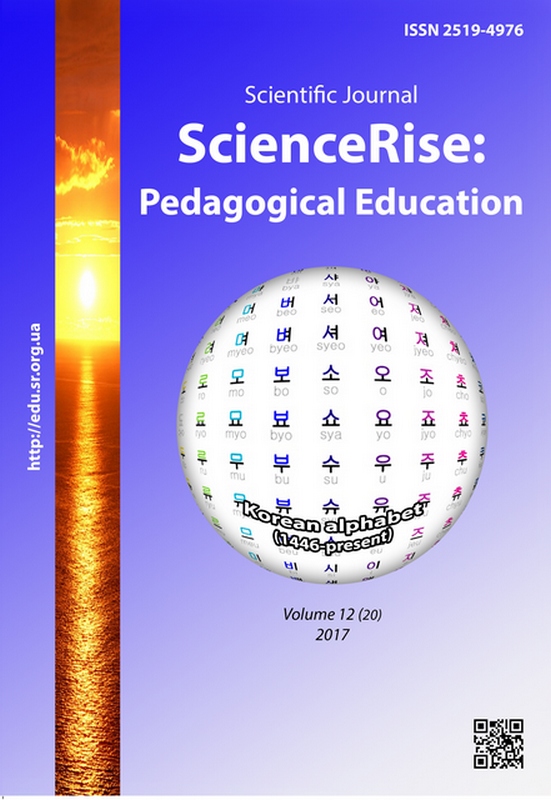Features of use cloud service Office 365 for organization of the educational process of higher educational institution
DOI:
https://doi.org/10.15587/2519-4984.2017.119580Keywords:
cloud technologies, cloud services, information technology, education, Microsoft Office 365, OneDriveAbstract
The article is devoted to problems of development and introduction of services of cloud technologies in the educational process. The need to search and develop new ways and means in education that involve the use of cloud technologies is described. The main concepts of information and communication technologies and cloud services are highlighted. Basic information about Google and Microsoft services and the benefits of working with them in the field of education are provided in the article. Microsoft Office365 services that provide ease of organization, fast work, online communication, the availability of any electronic resources in the activities of the educational institution are described. Overview of Office 365 services is reviewed, the features and uses of Microsoft Office 365 in the educational process are described. The possibilities of the Office 365 services that are used in the educational process of a higher educational institution are formulatedReferences
- Lytvynova, S. H. (Ed.) (2006). Dosvid uchyteliv Ukrainy z vykorystannia khmarnykh servisiv u systemi zahalnoi serednoi osvity [The experience of Ukraine's teachers on the use of cloud services in the system of general secondary education]. Kyiv: Komprynt, 310.
- Bykov, V. (2011). Khmarni tekhnolohiy, IKT-autsorsynh i novi funktsiy IKT pidrozdiliv osvitnikh i naukovykh ustanov [Cloud technologies, ICT outsourcing and new functions of ICT units of educational and scientific institutions]. Information technology in education, 10, 8–23.
- Lytvynova, S. (2015). Metodyka proektuvannia ta vykorystannia khmaro orientovanoho navchalnoho seredovyshcha zahalnoosvitnoho navchalnoho zakladu [Methodology of designing and using a cloud-based educational environment of a comprehensive educational institution]. Kyiv: Komprynt, 280.
- Lytvynova, S. (2015). Metodyka proektuvannia khmaro orientovanoho navchalnoho seredovyshcha zahalnoosvitnoho navchalnoho zakladu na rivni kerivnyka [Methodology of designing a cloud-based educational environment of a comprehensive educational institution at the level of the head]. Computer at school and family, 2 (122), 5–11.
- Burtovyi, S. Khmarni tekhnolohiy v osviti: Microsoft, Google, IBM. Available at: http://oin.in.ua/osvitni-hmary-microsoft-google-ibm-suchasni-instrumenty-formuvannya-osvitnoho-seredovyscha-navchalno-doslidnytskoji-diyalnosti-ditej/
- Kartashova, L. A. Khmarni tekhnolohiy yak skladnyk suchasnoho osvitnoho polikulturnoho seredovyshcha. Available at: http://lkartashova.at.ua/publ/khmarni_tekhnologiji_jak_skladnik_suchasnogo_osvitnogo_polikulturnogo_seredovishha/1-1-0-43
- Kademiya, M., Kobysia, V. (2012). Mozhlyvosti, shcho nadaiut khmarni tekhnolohiy. Khmarni tekhnolohiy v osviti: materialy Vseukrainskoho naukovo-metodychnoho Internet-seminaru. Kryvyi Rih: Vydavnychyi viddil KMI, 66–67.
- Shyshkina, M., Popel, M. (2013). Khmarno oriyentovane osvitnie seredovyshche navchalnoho zakladu: suchasnyi stan i perspektyvy rozvytku doslidzhen [The cloud-based educational environment of an educational institution: the current state and prospects of research development]. Information technologies and teaching aids, 5, 66–80.
- Lytvynova, S. H. (Ed.) (2015). Modeliuvannia y intehratsiya servisiv khmaro oriyentovanoho navchalnoho seredovyshcha [Simulation and integration of cloud-oriented learning environment services]. Kyiv: Komprynt, 163.
- Bykov, V. Yu. (2010). Suchasni zavdannia informatyzatsiy osvity. Informatsiyni tekhnolohiy i zasoby navchannia, 1 (15).
Downloads
Published
How to Cite
Issue
Section
License
Copyright (c) 2017 Nataliya Lishchyna, Valeriy Lishchyna

This work is licensed under a Creative Commons Attribution 4.0 International License.
Our journal abides by the Creative Commons CC BY copyright rights and permissions for open access journals.
Authors, who are published in this journal, agree to the following conditions:
1. The authors reserve the right to authorship of the work and pass the first publication right of this work to the journal under the terms of a Creative Commons CC BY, which allows others to freely distribute the published research with the obligatory reference to the authors of the original work and the first publication of the work in this journal.
2. The authors have the right to conclude separate supplement agreements that relate to non-exclusive work distribution in the form in which it has been published by the journal (for example, to upload the work to the online storage of the journal or publish it as part of a monograph), provided that the reference to the first publication of the work in this journal is included.








